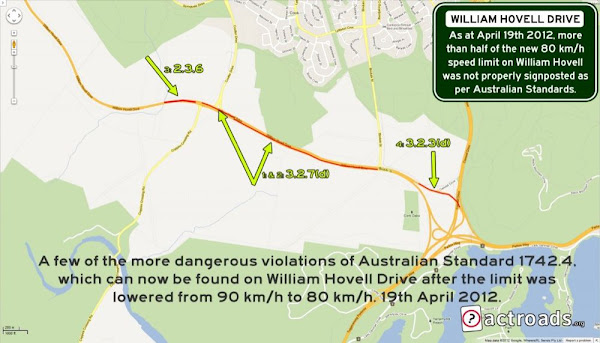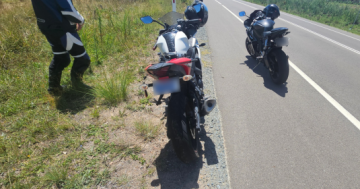My inevitable rant regarding the woeful implementation of the William Hovell Drive speed limit. Most notably, motorists who turn right onto William Hovell from Bindubi street, will not pass an 80 km/h sign for just under 2 km… yet mobile cameras are allowed to operate along the entire length of the road. Read on if interested.
—
On April 18th I received several emails asking why the speed limit had been reduced along William Hovell Drive. Initially I had no idea.
Today however a media release has been made available for public viewing. Tony Gill, director of Roads ACT stated that “There has been a total of 11 casualty crashes at the intersections of William Hovell Drive/Coppins Crossing Road and the intersection of William Hovell Drive/Bindubi Street in the last five years. A report completed in August 2011, which assessed the safety of William Hovell Drive, recommended that the speed limit be reduced from 90 km/h to 80 km.”
Fair enough. 90 km/h is a very high speed limit for an intersection controlled by traffic signals. I personally have seen the aftermath of a number of a large number of traffic collisions at Coppins Crossing Road, it is indeed a dangerous intersection.
That said, in true A.C.T Government and Roads A.C.T fashion however, multiple breaches of Australian Standards can be found with the new speed limit signage.
1. Most notably, motorists turning right onto William Hovell Drive from Bindubi Street will not pass a single 80 km/h speed limit sign for almost 2 km. The speed limit on William Hovell Drive had been 90 km/h for nearly two decades. Motorists who use the road frequently are almost certainly going to accelerate to 90 km/h out of habit along this stretch… particularly seeing as there are absolutely NO 80 km/h signs to warn them of the decreased speed limit.
This absurd oversight is in blatant violation of AS 1742.4 3.2.7(d), which clearly states that speed limit signs “…shall be provided just beyond important intersections for the benefit of traffic which has just turned from another road if the limit is other than the default limit.” “Where required just beyond a major intersection -a sign on both sides of the road 100–150 m (urban) or 300–400 m (rural) beyond the intersection” is required. It also demonstrates that whoever implemented the lower speed limit, carried out not quality assurance to ensure that no speed limit grey areas existed.
2. A similar situation applies for motorists turning out of Coppins Crossing Road, onto William Hovell Drive. No 80 km/h speed limit signs until they’ve driven 600 metres along William Hovell Drive. 600 metres is more than enough distance to accelerate up to 90 km/h.

“Plenty of messages can be found on William Hovell Drive reminding motorists not to exceed speed limits. However the new speed limit on William Hovell Drive is so poorly signposted, that motorists may travel throughout almost the entire zone without passing a single sign.”
3. A 500 metre offset speed limit applies at the western end of the new speed limit, where the speed limit on William Hovell Drive is now 80 km/h one way and 90 km/h the other. This is not compliant with AS 1742.4 2.3.6, which only permits differing speed limits for different directions of the same road in certain circumstances, none of which apply in this situation. Motorists, who are travelling Westbound on William Hovell Drive, are now permitted to accelerate from 80 km/h to 90 km/h, immediately before two lanes merge into one. Who on earth thought it was a good idea to permit drivers to speed up immediately before having to negotiate an often busy Form One Lane?
4. Road users heading eastbound on William Hovell Drive will re-enter a 90 km/h linear speed limit, immediately before they’re required to slow down to a recommended 75 km/h for the Glenloch interchange. Whoever has decided on this location for the speed limit boundary has overlooked AS 1742.4 3.2.3(d) which clearly states that “A change from a lower to a higher zoned speed limit should be avoided as far as practicable just in advance of a section of lower speed value alignment or hazard or other feature requiring a speed reduction. The lower speed limit should be carried through or past the section or feature.” The A.C.T Government could have carried the 80 km/h speed limit through the 75 km/h corner, without being in violation of the standard. Offset speed limit zones are permitted on divided roads where the characteristics of each carriageway differ and warrant different speed limits.

A map reflecting the dot points made above. As signposted, some motorists will not be aware of the new 80 km/h speed limit, until 2 km after they've turned onto William Hovell Drive. Mobile speed cameras operate along this entire road.
These rather gaping holes in speed limit signage were NOT caused by vandalism, they were NOT caused by adverse weather, they were NOT caused by aging signs… they were caused by an A.C.T Government Department continuing to possess an utterly nonchalant attitude when it comes to perhaps our most important road signs. Speed limit signs.
Road deaths are one of the leading causes of all deaths worldwide. The United Nations has labelled this decade “The Decade of Action for Road Safety.” The World Health Organisation has labelled excessive speed as being the leading cause of all road deaths. In order to have motorists slow down and respect speed limits, it is absolutely imperative that the A.C.T Government and Roads A.C.T employ speed limit signing and zoning techniques and protocols at are absolute, bullet proof and respectable by the majority of the population. If motorists respect speed limits, they’re more likely to obey them.
By continuing to set speed limits in a third world manner as is currently the case in the A.C.T, motorists are going to continue to ignore speed limits, and cry “revenue raising” when speed limits are heavily enforced. Rightfully so.
Mr Gill was quoted as saying “Motorists are urged to adhere to the new speed limit which is signposted.” Mr Gill, this is false. The new speed limit on William Hovell Drive is far from adequately signposted. Whoever signed off on this speed limit change in its current state clearly does not know what they’re doing.





















